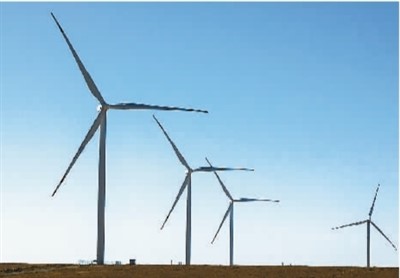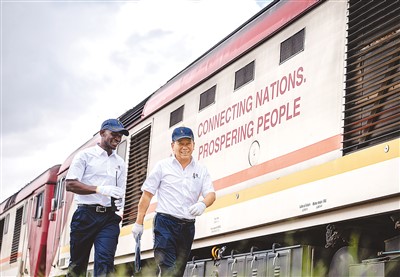




- BRNN
- BRI News
- BRNN News
- Database
Official Documents Polices and Regulations
Inter-government Documents International Cooperation BRI Countries
Business Guide Economic Data BRI Data
Trade
Investment Projects Latest projects
Cases - Content Pool

A staff member of China Energy Engineering Group Co., Ltd. introduces new energy, new infrastructure and new industries at the Boao Forum for Asia Annual Conference 2023. (Xinhua/Yang Guanyu)
China's green infrastructure experience has been "going global" over the course of the the joint construction of the Belt and Road Initiative (BRI), benefiting more and more countries and regions.
The Chinese mainland is moving towards green, low-carbon and resilient infrastructure construction, especially in the utilization of green energy and energy with near-zero carbon dioxide emissions, which have been widely applied in the infrastructure construction under the BRI, benefiting BRI partner countries and contributing to building a community with a shared future for mankind, said Chen Xiangsheng, an academician of the Chinese Academy of Engineering.
On Sept. 3, the Kanchanpur-Kamala Road project, which is part of the Nepal South Asia Sub-regional Economic Cooperation (SASEC) Highway Improvement Project and undertaken by China Railway Erju No.2 Engineering Co., Ltd., was awarded the title "Best Environmental Safeguards Monitoring Team" by Nepal's Ministry of Finance and the Asian Development Bank.
Green infrastructure projects in which China is participating are seen everywhere during the joint construction of the Belt and Road.
Fang Qiuchen, president of the China International Contractors Association, said Chinese contractors have played an active role in the transition to green and low-carbon infrastructure in various countries. In the past decade, Chinese companies have completed over 3,000 infrastructure projects in countries participating in the BRI, including many green energy, green transportation and green building projects.
In Laos, the China-Laos Railway, a landmark project of high-quality BRI cooperation, has set a benchmark for green and sustainable infrastructure projects.

Photo shows the Lusail Stadium in Doha, Qatar. (Handout via Xinhua)
In Qatar, the China-backed Lusail Stadium, the main venue of the FIFA World Cup 2022, is a miracle construction of a high-quality eco-friendly structure in a desert area. Adopting multiple innovative environmental protection and energy-saving technologies and using recyclable materials, this modern stadium saved 40 percent in freshwater consumption compared with building a conventional stadium.
In Kazakhstan, China-backed new energy projects like the Zhanatas wind farm and the Turgusun Hydropower Station are contributing to the country's low-carbon transition.

Photo shows wind turbines at the Zhanatas wind farm in Kazakhstan. (Handout via Xinhua)
In Uzbekistan, China Construction Fifth Engineering Division Corp., Ltd. is taking part in the construction of the Syr Darya 1500MW combined-cycle gas turbine plant. The plant is using the gas turbine with the highest combustion temperature, the largest single source of power and the highest efficiency in the world, as well as a zero waste water discharge design scheme. Once completed, it will be able to provide over 36 million kilowatt-hours of electricity to the local power grid every day, promoting Uzbekistan's green development.
Fang believes that in the decade since the BRI was proposed, Chinese contractors have actively implemented the green Belt and Road principles advocated by the Chinese government. They have made concrete efforts and contributions to tackling climate change and achieving the United Nations' Sustainable Development Goals by building green, low-carbon and eco-friendly infrastructure projects worldwide.
In designing and undertaking BRI projects, Chinese enterprises are taking ecological factors into full consideration to help conserve biodiversity, gaining recognition from local governments and people, said Zhou Guomei, director-general of the Department of International Cooperation of the Ministry of Ecology and Environment.
For example, while building the Karakoram Highway in Pakistan, Chinese companies planted nearly 300,000 trees and more than 5 million square meters of grass along the highway, playing their part in greening the local environment during the infrastructure construction process.
The Chinese company involved in the construction of the new container terminal in Ghana's Tema paid special attention to protecting biodiversity and built a sea turtle hatchery to protect the vulnerable species.

A train driver (R) and his apprentice walk past a train carriage on the Mombasa-Nairobi Standard Gauge Railway in Nairobi, Kenya. (Xinhua/Wang Guansen)
During the construction of the Mombasa-Nairobi Standard Gauge Railway, which connects Mombasa, the largest port in East Africa, and Nairobi, the capital of Kenya, the Chinese company involved built bridges along the railway line to ensure the free movement of wild animals, including those of more than 7 meters high that allow giraffes to pass without having to bend their necks.
By embracing green and low-carbon concepts during the construction of projects, Chinese companies have made positive contributions to protecting the environment while pursuing economic and social progress in BRI partner countries, Zhou added.

A train passes by a village along the China-Laos Railway in Menghan town, Jinghong city, southwest China's Yunnan Province. (Handout via Xinhua)
In recent years, China has continuously advanced the green development of the BRI. According to a white paper titled "The Belt and Road Initiative: A Key Pillar of the Global Community of Shared Future" issued by the State Council Information Office, China has issued documents such as the Guidance on Promoting Green Belt and Road and the Guidelines on Jointly Promoting Green Development of the Belt and Road, and set itself the ambitious goal of forming a basic framework of green development through BRI cooperation by 2030.
China has pledged to stop building new coal-fired power stations overseas, and to actively build green finance platforms and international cooperation mechanisms. It stands ready to cooperate with BRI partner countries on research into biodiversity conservation, safeguarding the eco-environmental security of the Maritime Silk Road, building the Belt and Road Big Data Service Platform on Ecological and Environmental Protection and the Belt and Road Environmental Technology Exchange and Transfer Center, and implementing the Green Silk Road Envoys Program. As of the beginning of 2023, China had trained more than 3,000 talents in green development for over 120 countries.

Tel:86-10-65368972, 86-10-65369967